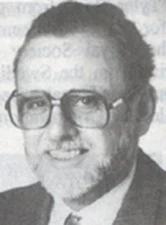Peter Eberhardt

The 1994 David Bates Medal is awarded to Peter Eberhardt given in recognition of his outstanding achievements in the study of radiogenic, spallogenic and solar wind implanted rare gases in meteorites, in the determination of the composition of the solar wind and in the investigation of Comet Halley during the Giotto Mission.
Working with Prof. F.G. Houtermans, Peter Eberhardt received his PhD at the University of Bern in 1956. Thereafter he worked with Prof. H.C. Urey in Chicago and then La Jolla on systematic studies of the He and Ne isotopes in stone meteorites. Continuing this work after his return to Bern, he found a correlation of the spallation Ne isotopic composition with the 3He/22Ne ratio and with the depth of the sample in a meteorite (Bern-plot) and he was able to show that the noble gases trapped in many meteorites are implanted solar wind ions. The later discovery led to the Swiss Solar Wind Composition Experiment, an Al-foil set up on the Moon by Apollo astronauts which yielded the first direct precise determination of the He, Ne, and Ar abundance in the solar wind and the isotopic composition. With his associates he also measured solar wind implanted rare gases in the lunar soil as well as formation ages and cosmic ray exposure ages of lunar rocks and he was successful in dating lunar craters such as Copernicus.
Peter Eberhardt’s name is also closely connected with the observation that the highly anomalous Ne-E component in carbonaceous meteorites is monoisotopic 22Ne. This unusual isotopic composition could only be explained by a direct nulceosynthetic origin of Ne-E.
Since the late, 1960, Peter Eberhardt participated in a large number of space research projects. For the Giotto Mission to comet P/Halley he conceived a novel double-focusing mass spectrometer especially suited for this ambitious fast fly-by mission. Together with colleagues from Germany, France and the US, he integrated this design in the Neutral Mass Spectrometer experiment for Giotto. The NMS was highly successful. Water was unambiguously identified as the dominant volatile. Other gases released from the nucleus of the comet were carbon dioxide, carbon monoxide, methanol and hydrogen sulfide. The NMS also provided the first measurement of the D/H ratio of water and methanol of the comet. Peter Eberhardt served in many scientific committees of the European Space Agency. For nearly a decade he was a member of the science working group which studied cometary missions. These studies lead to the Rosetta Comet Rendezvous Mission which has recently been accepted as the third corner stone mission in ESA’s Horizon 2000 plan.
Newsletter 51, 28, 1994
